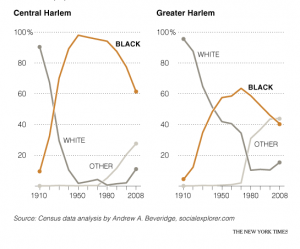In 1910, African-Americans contributed to only 9.89% of Harlem’s population. This proportion shifted to 32.43% by 1920, and to 70.18% by 1930. This massive shift in the demography resulted from influx of black migrants and immigrants, as well as the departure of many whites. The streets between Lenox and Fifth Avenues were densely residential to begin with, and served as the seed for the nucleation of the black community’s growth.

As migrants from the South and immigrants from the West Indies arrived in northern cities, distinct clusters formed throughout neighbourhoods. This clustering existed on a scale as small as individual buildings. In 1903, a building at West 134st become the first all black tenant building in Harlem. Black buildings gave rise to black residential blocks, and the reach of the African-American residences expanded from the early 1900s to 1930. In 1920, 130th and 144th Streets defined the north-south limits of the community. By 1930, the limit expanded to 110th and 160th Streets, allowing Harlem to border the Spanish-speaking neighbourhoods of Puerto Rican and Caribbean people to the south.
Neighbourhoods within Harlem became black, but they were definitely not homogenous. The distribution of different, but important, social landmarks such as churches and fraternal lodges, as well as the clustering tendency of southern migrants and West Indies immigrants, contributed to a mosaic Harlem. Many streets were densely residential between Lenox and Fifth Avenues, but streets varied in their composition of people and places. The structure of Harlem was much more complicated than suggested by the historical distinction between whites and blacks. Walking the various streets would have revealed a spatial heterogeneity.